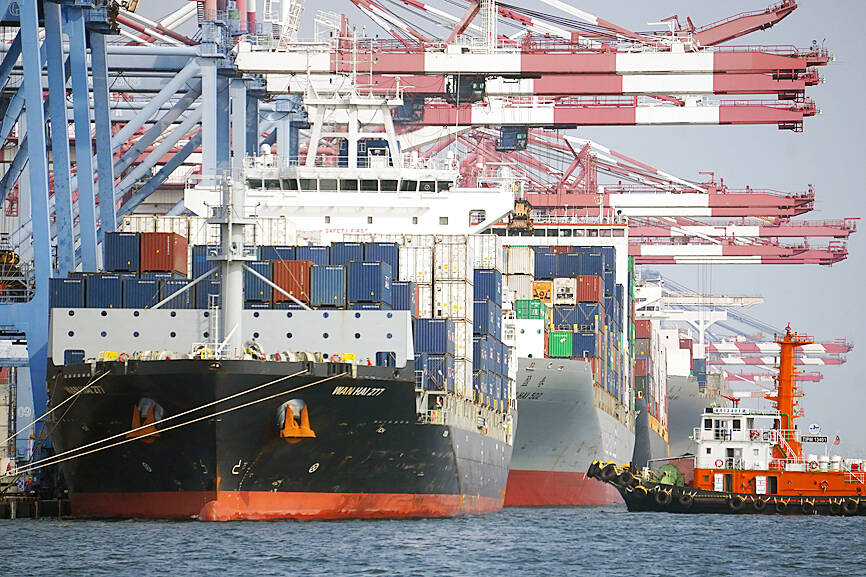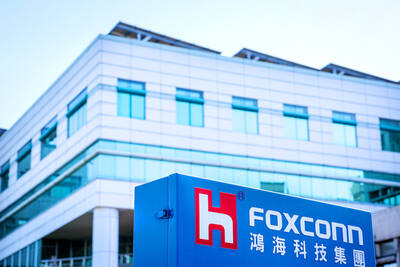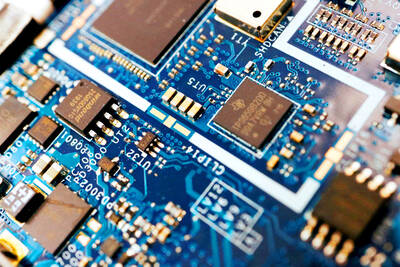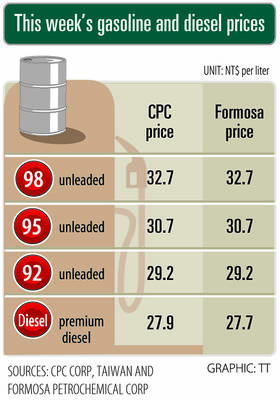The Taiwanese economy shrank at the sharpest pace since 2009, recording its second quarter of contraction in a row as a plunge in global demand for chips showed little sign of abating.
GDP in the first quarter of this year dropped 3.02 percent from the same period last year, the sharpest fall since June 2009, the Directorate-General of Budget, Accounting and Statistics (DBGAS) said.
Economists surveyed by Bloomberg forecast a fall of 1.25 percent.

Photo: CNA
“The first-quarter GDP is worse than expected, as exports and corporate investment contracted more harshly than our forecast,” DGBAS statistics division head Wu Pei-hsuan (吳佩璇) told a news conference in Taipei.
The agency expected GDP to decline at annual rate of 1.2 percent last quarter, Wu said.
The weaker-than-expected economic performance prompted the DGBAS to cut its GDP growth forecast for this year to 1.67 percent, from its estimate of 2.12 percent growth in February.
Concerning the new GDP growth estimate, Wu said there was still a chance that Taiwan sees an economic growth rate of more than 2 percent, taking into account the effects of NT$6,000 rebates to Taiwanese and eligible foreign residents, which are forecast to boost GDP growth by 0.35 to 0.45 percentage points.
Private consumption in the first quarter grew 6.6 percent from a year earlier, mainly driven by a robust rebound in spending on dining in, accommodation, recreation and transportation, DGBAS data showed.
The consumption growth rate was 2.37 percentage points higher than the previous forecast made in February, it said.
The worse-than-expected contraction highlights an ongoing struggle to rediscover growth as Taiwanese exporters contend with falling overseas demand for their products.
Chip heavyweight Taiwan Semiconductor Manufacturing Co (台積電) said in an earnings call last week that the second quarter would likely be the bottom of the current business cycle before demand recovers later in the year.
Compounding the issue is a shortfall of workers willing to take jobs in the services industry, hampering domestic demand from mitigating the lackluster performance of the export sector.
The latest figures run counter to burgeoning signs of improvement in other export economies in the region.
South Korea’s GDP grew 0.3 percent in the first quarter, more than economists had expected.
South Korean officials project growth to pick up further by the end of the year.
China — Taiwan’s largest export market — saw its economy expand 4.5 percent in the first quarter. That was fueled in large part by surging consumption as shoppers, travelers and diners increased spending as the country’s strict COVID-19 controls ended.
There are some small signs of potential improvement for Taiwan.
The government’s monitoring indicator, an index of forward-looking data points, gained last month.
While the index’s reading of 11 indicates that the economy remains “sluggish,” it was the first improvement in the data since October last year.

Hon Hai Precision Industry Co (鴻海精密) yesterday said that its research institute has launched its first advanced artificial intelligence (AI) large language model (LLM) using traditional Chinese, with technology assistance from Nvidia Corp. Hon Hai, also known as Foxconn Technology Group (富士康科技集團), said the LLM, FoxBrain, is expected to improve its data analysis capabilities for smart manufacturing, and electric vehicle and smart city development. An LLM is a type of AI trained on vast amounts of text data and uses deep learning techniques, particularly neural networks, to process and generate language. They are essential for building and improving AI-powered servers. Nvidia provided assistance

DOMESTIC SUPPLY: The probe comes as Donald Trump has called for the repeal of the US$52.7 billion CHIPS and Science Act, which the US Congress passed in 2022 The Office of the US Trade Representative is to hold a hearing tomorrow into older Chinese-made “legacy” semiconductors that could heap more US tariffs on chips from China that power everyday goods from cars to washing machines to telecoms equipment. The probe, which began during former US president Joe Biden’s tenure in December last year, aims to protect US and other semiconductor producers from China’s massive state-driven buildup of domestic chip supply. A 50 percent US tariff on Chinese semiconductors began on Jan. 1. Legacy chips use older manufacturing processes introduced more than a decade ago and are often far simpler than

STILL HOPEFUL: Delayed payment of NT$5.35 billion from an Indian server client sent its earnings plunging last year, but the firm expects a gradual pickup ahead Asustek Computer Inc (華碩), the world’s No. 5 PC vendor, yesterday reported an 87 percent slump in net profit for last year, dragged by a massive overdue payment from an Indian cloud service provider. The Indian customer has delayed payment totaling NT$5.35 billion (US$162.7 million), Asustek chief financial officer Nick Wu (吳長榮) told an online earnings conference. Asustek shipped servers to India between April and June last year. The customer told Asustek that it is launching multiple fundraising projects and expected to repay the debt in the short term, Wu said. The Indian customer accounted for less than 10 percent to Asustek’s

Gasoline and diesel prices this week are to decrease NT$0.5 and NT$1 per liter respectively as international crude prices continued to fall last week, CPC Corp, Taiwan (CPC, 台灣中油) and Formosa Petrochemical Corp (台塑石化) said yesterday. Effective today, gasoline prices at CPC and Formosa stations are to decrease to NT$29.2, NT$30.7 and NT$32.7 per liter for 92, 95 and 98-octane unleaded gasoline respectively, while premium diesel is to cost NT$27.9 per liter at CPC stations and NT$27.7 at Formosa pumps, the companies said in separate statements. Global crude oil prices dropped last week after the eight OPEC+ members said they would